Case Study: Essendon Football Club - Sport Governance and Strategy
VerifiedAdded on 2020/03/16
|5
|1077
|31
Case Study
AI Summary
This case study analyzes the Essendon Football Club's doping scandal, examining the risks faced by the club and board members upon receiving allegations of doping. The analysis explores the responsibilities of the senior coach, CEO, and board in preventing the situation, including the role of the conflict between winning and adhering to rules. The study highlights the importance of proper human resource management, financial controls, and clear delegation of duties to prevent such crises. The CEO's ultimate responsibility is discussed, alongside the potential impact of tighter expenditure approvals and reporting. The case underscores the importance of strong governance and accountability within sports organizations to maintain integrity and public trust, also it focuses on how the board could have prevented the situation from arising at early stages.
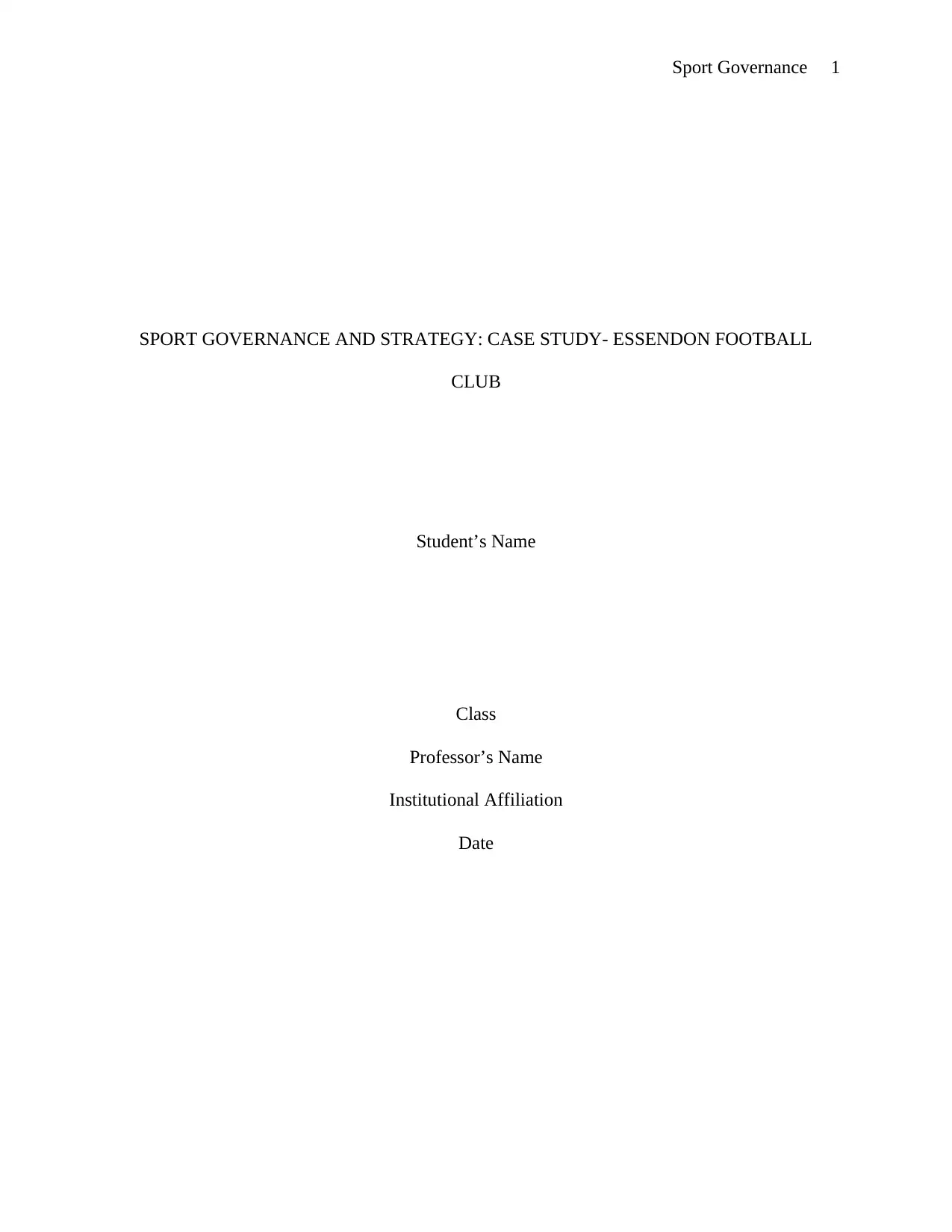
Sport Governance 1
SPORT GOVERNANCE AND STRATEGY: CASE STUDY- ESSENDON FOOTBALL
CLUB
Student’s Name
Class
Professor’s Name
Institutional Affiliation
Date
SPORT GOVERNANCE AND STRATEGY: CASE STUDY- ESSENDON FOOTBALL
CLUB
Student’s Name
Class
Professor’s Name
Institutional Affiliation
Date
Paraphrase This Document
Need a fresh take? Get an instant paraphrase of this document with our AI Paraphraser
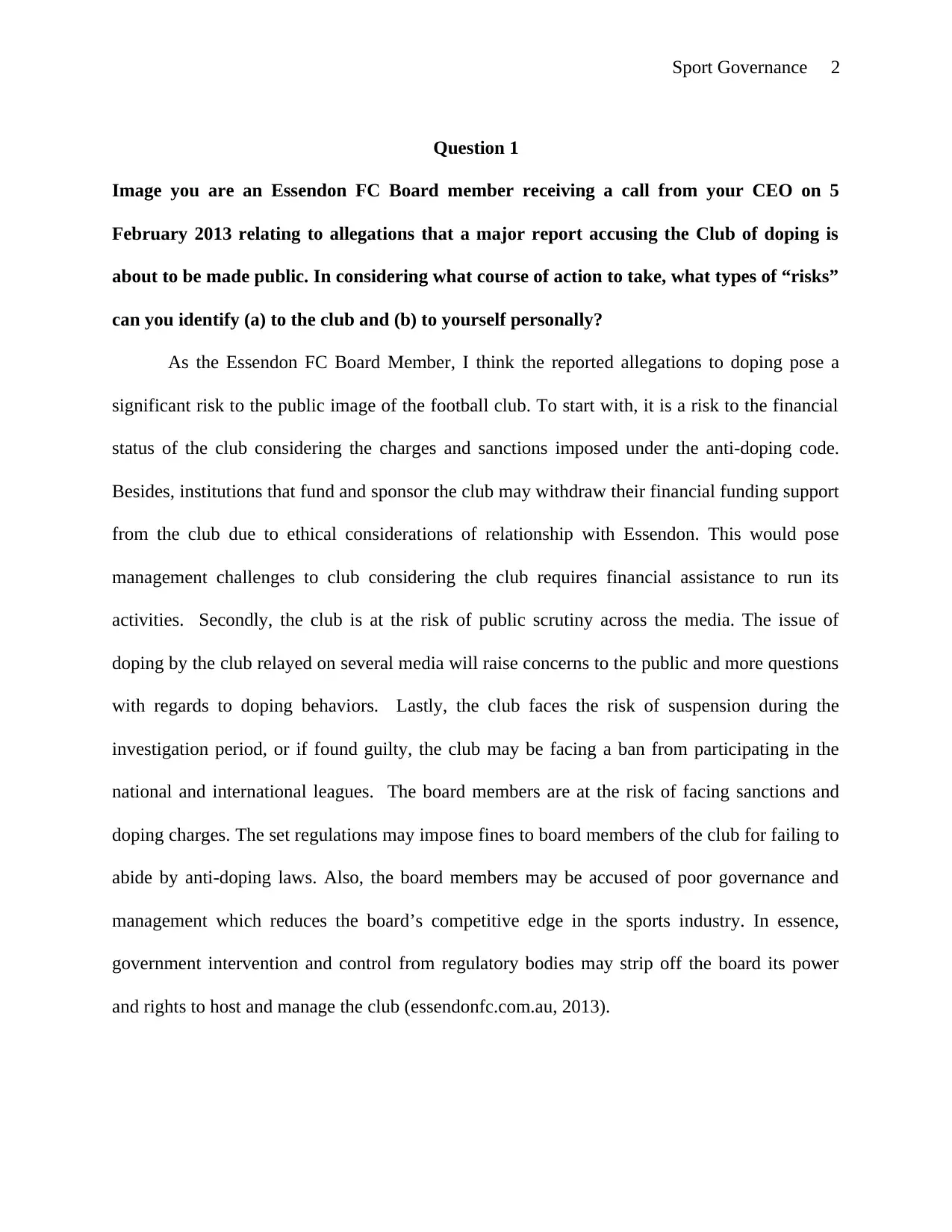
Sport Governance 2
Question 1
Image you are an Essendon FC Board member receiving a call from your CEO on 5
February 2013 relating to allegations that a major report accusing the Club of doping is
about to be made public. In considering what course of action to take, what types of “risks”
can you identify (a) to the club and (b) to yourself personally?
As the Essendon FC Board Member, I think the reported allegations to doping pose a
significant risk to the public image of the football club. To start with, it is a risk to the financial
status of the club considering the charges and sanctions imposed under the anti-doping code.
Besides, institutions that fund and sponsor the club may withdraw their financial funding support
from the club due to ethical considerations of relationship with Essendon. This would pose
management challenges to club considering the club requires financial assistance to run its
activities. Secondly, the club is at the risk of public scrutiny across the media. The issue of
doping by the club relayed on several media will raise concerns to the public and more questions
with regards to doping behaviors. Lastly, the club faces the risk of suspension during the
investigation period, or if found guilty, the club may be facing a ban from participating in the
national and international leagues. The board members are at the risk of facing sanctions and
doping charges. The set regulations may impose fines to board members of the club for failing to
abide by anti-doping laws. Also, the board members may be accused of poor governance and
management which reduces the board’s competitive edge in the sports industry. In essence,
government intervention and control from regulatory bodies may strip off the board its power
and rights to host and manage the club (essendonfc.com.au, 2013).
Question 1
Image you are an Essendon FC Board member receiving a call from your CEO on 5
February 2013 relating to allegations that a major report accusing the Club of doping is
about to be made public. In considering what course of action to take, what types of “risks”
can you identify (a) to the club and (b) to yourself personally?
As the Essendon FC Board Member, I think the reported allegations to doping pose a
significant risk to the public image of the football club. To start with, it is a risk to the financial
status of the club considering the charges and sanctions imposed under the anti-doping code.
Besides, institutions that fund and sponsor the club may withdraw their financial funding support
from the club due to ethical considerations of relationship with Essendon. This would pose
management challenges to club considering the club requires financial assistance to run its
activities. Secondly, the club is at the risk of public scrutiny across the media. The issue of
doping by the club relayed on several media will raise concerns to the public and more questions
with regards to doping behaviors. Lastly, the club faces the risk of suspension during the
investigation period, or if found guilty, the club may be facing a ban from participating in the
national and international leagues. The board members are at the risk of facing sanctions and
doping charges. The set regulations may impose fines to board members of the club for failing to
abide by anti-doping laws. Also, the board members may be accused of poor governance and
management which reduces the board’s competitive edge in the sports industry. In essence,
government intervention and control from regulatory bodies may strip off the board its power
and rights to host and manage the club (essendonfc.com.au, 2013).
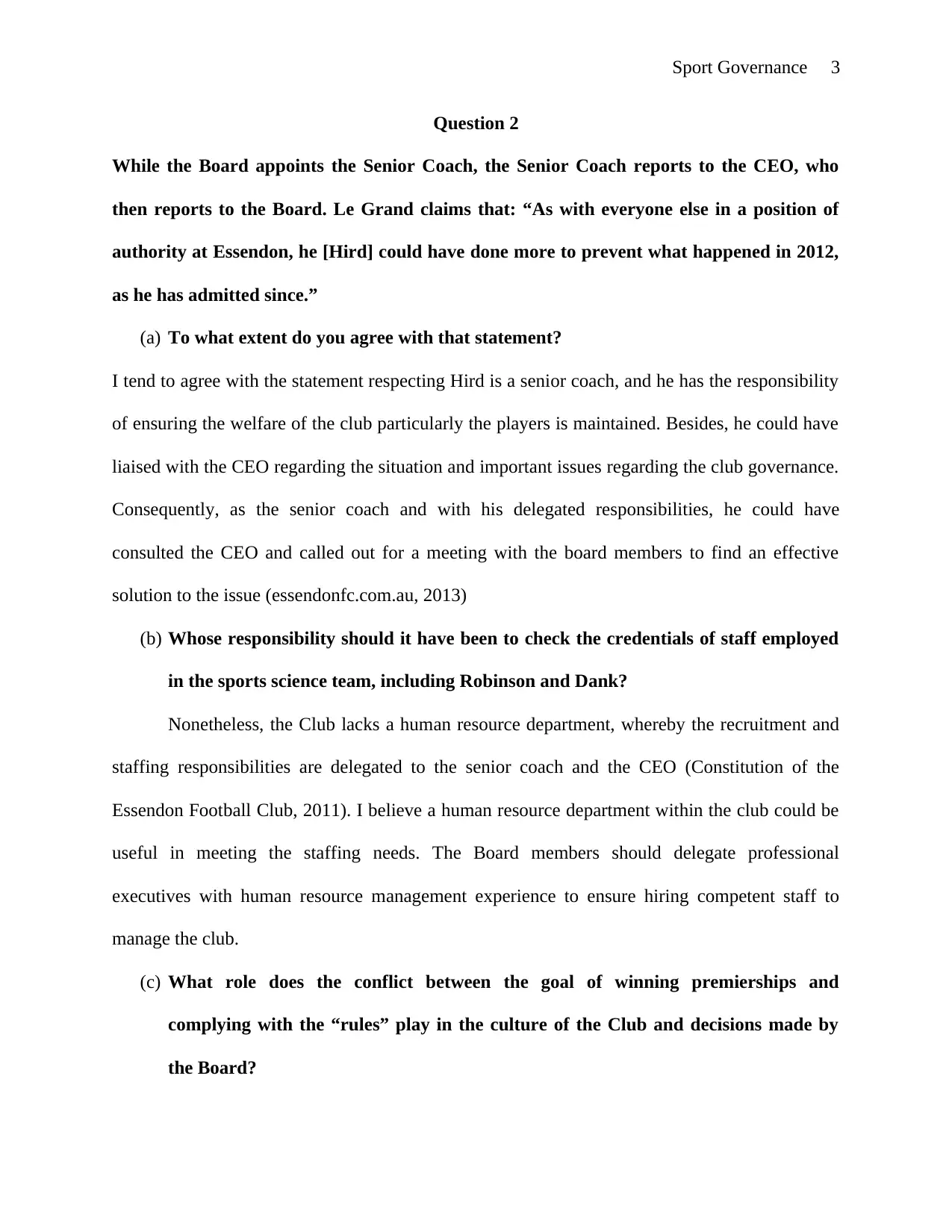
Sport Governance 3
Question 2
While the Board appoints the Senior Coach, the Senior Coach reports to the CEO, who
then reports to the Board. Le Grand claims that: “As with everyone else in a position of
authority at Essendon, he [Hird] could have done more to prevent what happened in 2012,
as he has admitted since.”
(a) To what extent do you agree with that statement?
I tend to agree with the statement respecting Hird is a senior coach, and he has the responsibility
of ensuring the welfare of the club particularly the players is maintained. Besides, he could have
liaised with the CEO regarding the situation and important issues regarding the club governance.
Consequently, as the senior coach and with his delegated responsibilities, he could have
consulted the CEO and called out for a meeting with the board members to find an effective
solution to the issue (essendonfc.com.au, 2013)
(b) Whose responsibility should it have been to check the credentials of staff employed
in the sports science team, including Robinson and Dank?
Nonetheless, the Club lacks a human resource department, whereby the recruitment and
staffing responsibilities are delegated to the senior coach and the CEO (Constitution of the
Essendon Football Club, 2011). I believe a human resource department within the club could be
useful in meeting the staffing needs. The Board members should delegate professional
executives with human resource management experience to ensure hiring competent staff to
manage the club.
(c) What role does the conflict between the goal of winning premierships and
complying with the “rules” play in the culture of the Club and decisions made by
the Board?
Question 2
While the Board appoints the Senior Coach, the Senior Coach reports to the CEO, who
then reports to the Board. Le Grand claims that: “As with everyone else in a position of
authority at Essendon, he [Hird] could have done more to prevent what happened in 2012,
as he has admitted since.”
(a) To what extent do you agree with that statement?
I tend to agree with the statement respecting Hird is a senior coach, and he has the responsibility
of ensuring the welfare of the club particularly the players is maintained. Besides, he could have
liaised with the CEO regarding the situation and important issues regarding the club governance.
Consequently, as the senior coach and with his delegated responsibilities, he could have
consulted the CEO and called out for a meeting with the board members to find an effective
solution to the issue (essendonfc.com.au, 2013)
(b) Whose responsibility should it have been to check the credentials of staff employed
in the sports science team, including Robinson and Dank?
Nonetheless, the Club lacks a human resource department, whereby the recruitment and
staffing responsibilities are delegated to the senior coach and the CEO (Constitution of the
Essendon Football Club, 2011). I believe a human resource department within the club could be
useful in meeting the staffing needs. The Board members should delegate professional
executives with human resource management experience to ensure hiring competent staff to
manage the club.
(c) What role does the conflict between the goal of winning premierships and
complying with the “rules” play in the culture of the Club and decisions made by
the Board?
⊘ This is a preview!⊘
Do you want full access?
Subscribe today to unlock all pages.

Trusted by 1+ million students worldwide
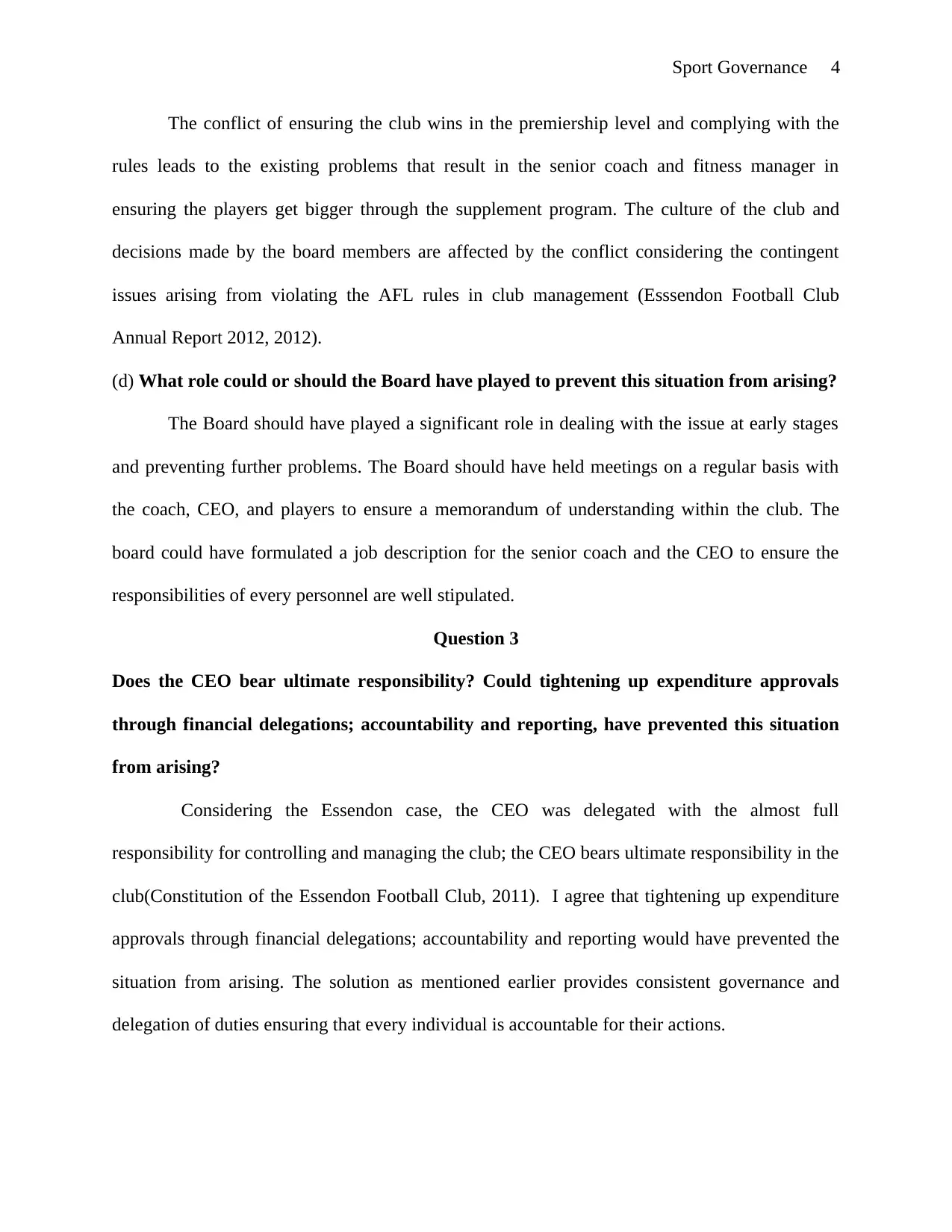
Sport Governance 4
The conflict of ensuring the club wins in the premiership level and complying with the
rules leads to the existing problems that result in the senior coach and fitness manager in
ensuring the players get bigger through the supplement program. The culture of the club and
decisions made by the board members are affected by the conflict considering the contingent
issues arising from violating the AFL rules in club management (Esssendon Football Club
Annual Report 2012, 2012).
(d) What role could or should the Board have played to prevent this situation from arising?
The Board should have played a significant role in dealing with the issue at early stages
and preventing further problems. The Board should have held meetings on a regular basis with
the coach, CEO, and players to ensure a memorandum of understanding within the club. The
board could have formulated a job description for the senior coach and the CEO to ensure the
responsibilities of every personnel are well stipulated.
Question 3
Does the CEO bear ultimate responsibility? Could tightening up expenditure approvals
through financial delegations; accountability and reporting, have prevented this situation
from arising?
Considering the Essendon case, the CEO was delegated with the almost full
responsibility for controlling and managing the club; the CEO bears ultimate responsibility in the
club(Constitution of the Essendon Football Club, 2011). I agree that tightening up expenditure
approvals through financial delegations; accountability and reporting would have prevented the
situation from arising. The solution as mentioned earlier provides consistent governance and
delegation of duties ensuring that every individual is accountable for their actions.
The conflict of ensuring the club wins in the premiership level and complying with the
rules leads to the existing problems that result in the senior coach and fitness manager in
ensuring the players get bigger through the supplement program. The culture of the club and
decisions made by the board members are affected by the conflict considering the contingent
issues arising from violating the AFL rules in club management (Esssendon Football Club
Annual Report 2012, 2012).
(d) What role could or should the Board have played to prevent this situation from arising?
The Board should have played a significant role in dealing with the issue at early stages
and preventing further problems. The Board should have held meetings on a regular basis with
the coach, CEO, and players to ensure a memorandum of understanding within the club. The
board could have formulated a job description for the senior coach and the CEO to ensure the
responsibilities of every personnel are well stipulated.
Question 3
Does the CEO bear ultimate responsibility? Could tightening up expenditure approvals
through financial delegations; accountability and reporting, have prevented this situation
from arising?
Considering the Essendon case, the CEO was delegated with the almost full
responsibility for controlling and managing the club; the CEO bears ultimate responsibility in the
club(Constitution of the Essendon Football Club, 2011). I agree that tightening up expenditure
approvals through financial delegations; accountability and reporting would have prevented the
situation from arising. The solution as mentioned earlier provides consistent governance and
delegation of duties ensuring that every individual is accountable for their actions.
Paraphrase This Document
Need a fresh take? Get an instant paraphrase of this document with our AI Paraphraser
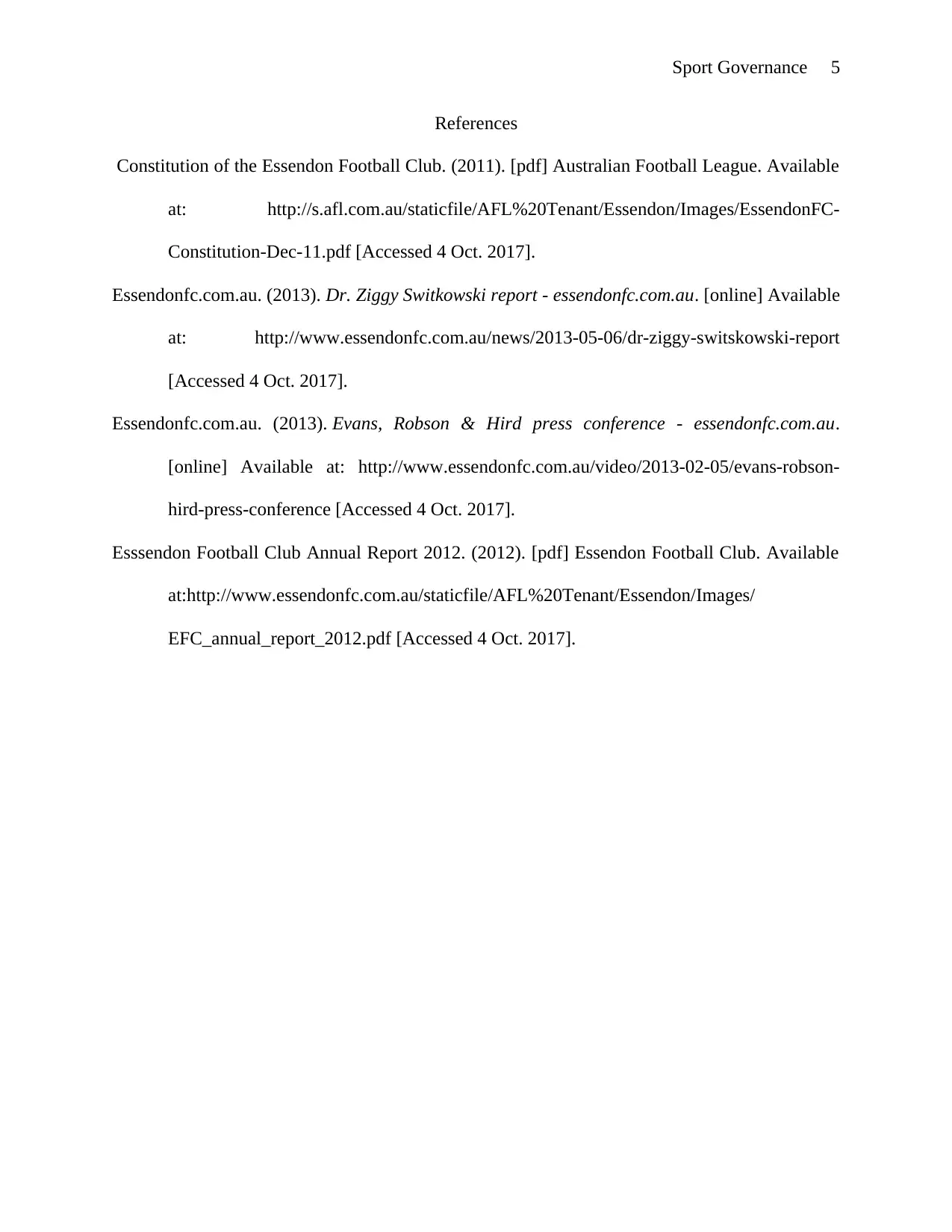
Sport Governance 5
References
Constitution of the Essendon Football Club. (2011). [pdf] Australian Football League. Available
at: http://s.afl.com.au/staticfile/AFL%20Tenant/Essendon/Images/EssendonFC-
Constitution-Dec-11.pdf [Accessed 4 Oct. 2017].
Essendonfc.com.au. (2013). Dr. Ziggy Switkowski report - essendonfc.com.au. [online] Available
at: http://www.essendonfc.com.au/news/2013-05-06/dr-ziggy-switskowski-report
[Accessed 4 Oct. 2017].
Essendonfc.com.au. (2013). Evans, Robson & Hird press conference - essendonfc.com.au.
[online] Available at: http://www.essendonfc.com.au/video/2013-02-05/evans-robson-
hird-press-conference [Accessed 4 Oct. 2017].
Esssendon Football Club Annual Report 2012. (2012). [pdf] Essendon Football Club. Available
at:http://www.essendonfc.com.au/staticfile/AFL%20Tenant/Essendon/Images/
EFC_annual_report_2012.pdf [Accessed 4 Oct. 2017].
References
Constitution of the Essendon Football Club. (2011). [pdf] Australian Football League. Available
at: http://s.afl.com.au/staticfile/AFL%20Tenant/Essendon/Images/EssendonFC-
Constitution-Dec-11.pdf [Accessed 4 Oct. 2017].
Essendonfc.com.au. (2013). Dr. Ziggy Switkowski report - essendonfc.com.au. [online] Available
at: http://www.essendonfc.com.au/news/2013-05-06/dr-ziggy-switskowski-report
[Accessed 4 Oct. 2017].
Essendonfc.com.au. (2013). Evans, Robson & Hird press conference - essendonfc.com.au.
[online] Available at: http://www.essendonfc.com.au/video/2013-02-05/evans-robson-
hird-press-conference [Accessed 4 Oct. 2017].
Esssendon Football Club Annual Report 2012. (2012). [pdf] Essendon Football Club. Available
at:http://www.essendonfc.com.au/staticfile/AFL%20Tenant/Essendon/Images/
EFC_annual_report_2012.pdf [Accessed 4 Oct. 2017].
1 out of 5
Your All-in-One AI-Powered Toolkit for Academic Success.
+13062052269
info@desklib.com
Available 24*7 on WhatsApp / Email
![[object Object]](/_next/static/media/star-bottom.7253800d.svg)
Unlock your academic potential
Copyright © 2020–2025 A2Z Services. All Rights Reserved. Developed and managed by ZUCOL.
